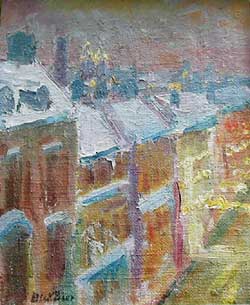
Expressionist roofs, 1928
Today, Dick Beer is represented in half a dozen Swedish art museums (among others Moderna Muséet and Nationalmuseum in Stockholm, Norrköpings Museum and the State Portrait Collection). The artist himself would surely have commented: “A fat lot of good that will do to me!” Many have forgotten that his clear period, neo- or postimpressionist, is remarkable and also quite unique in Swedish painting. We could talk of the famous Nordic light, but Dick Beer’s works between 1913 and 1917 are not representative of Swedish tradition nor are they wholly French. These canvases full of light are easy and not so easy in the same time. The twenties are another golden period which Ragnar Hoppe counts among his best. We have in particular several nudes combining the sensuality of Renoir with the mother-of-pearl shades of Bonnard, according to certain critics.
The academy director, painter and art writer Kåge Liefwendal registered in 1947:
“His great passion was the nude. He had a realistic approach. But it happened that he worked so intensely with his models that he reached the shimmering dreamland of a vision. He succeeded in this especially in smaller nude sketches, with the model posed against a white sheet. I hardly know of any Swedish painter who went so much for nude painting since Zorn. He didn’t have any particular type of nude, as Zorn’s Dalecarlian girl or Renoir’s black-eyed Demeter. But his joy of painting exploded when receiving a particular red-haired model with a milk-white ebony complexion.“
In the thirties, compositions are more serene, harmony is dominating, the still life are discreet, almost minimalist. As a landscape painter, he succeeds equally in catching the sky in southern France, the sea in Bretagne, mineral-tone lakes in Sweden or a February day in Stockholm when the snow still covers the cobblestones. Dick Beer didn’t escape from the melancholy so frequently present in the Scandinavian mood, but he is a steady rebel against any atavistic condition, his facility of speech is Gallic and the culture universal. Severely wounded in the war, he never recovered the health. He had several nervous breakdowns, could become clearly paranoid at occasions (documented by Kåge Liefwendal) and had to be treated. He was drug-dependent in periods (veronal and probably also opium). His physical sufferings were very real. During weeks, he could not even take a brush in his hands. But between the crisis and the days of illness, his thirst of life could burst out overwhelmingly. As his friend Modigliani, Beer is a cursed painter. But is he a Swedish painter, as Edward Munch was a Norwegian ? In 1896-97 in Paris, attracted by the symbolists and the nabis, Munch definitely is seen as a universal painter. After 1908, Munch fixes himself in his homeland, and the expressive tension in his paintings belongs then entirely to the Nordic soul. Dick Beer’s approach is rather ambiguous. Born and educated in London, an occasional visitor to Sweden (generally during summers), residing in Paris,” my city he” said, Dick Beer was only a Swede in counterpoint, so to speak. He always marked his distance to Sweden, having difficulties in standing the coldness and provincialism of people there. The relation is one of love-hate. Dick Beer needs Sweden, he does not detach himself from it in his artistic expression, but he needs in the same time other spiritual foods, and enormously so. In Stockholm, he is capable of shouting “Vive la France” in public, and that is not common. Fifteen years after having left England (he rarely returned and never for a long time, as his only surviving brother had departed for New Zealand), he still kept a British passport.
When he painted and felt things went his way, he whistled French war tunes such as” Le Père de la Victoire” and “Sambre-et-Meuse” or sentimental waltzes from London at the time of the Boer War, as his colleague and friend in Paris Bertil Bull Hedlund recalls it.
From the UK he kept a dry sense of humour. But his cultural model was of course France to which he dedicated a cult. He mastered perfectly Molière’s tongue, he was a volunteer in the Légion étrangère to stand up against the Germans (first as a soldier then as an ambulance man). He talked of his admiration for “the sense of balance” in French society, but he was always eager to see life much bigger than it really were. One of his friends tells how Whistler, when visiting the Beer family in London, gently tried to get Oscar Wilde to show a little modesty when the playwright pushed his famous paradoxes a trifle too far, exclaiming: “Don’t overdo it, my dear Oscar”. Dick Beer, in his social life, often overdid it, being caustic, brilliant and a self-learnt erudite. He had read all the big writers, he quoted the Middle Age poet François Villon, Balzac and Shakespeare, more seldom Swedish authors. He was a cultural entertainer and a charismatic person. But most of all he was a European, at a time when the idea of a United States of Europe began to appeal to intellectuals, on the ruins lefts after the Great War.
(Continued)